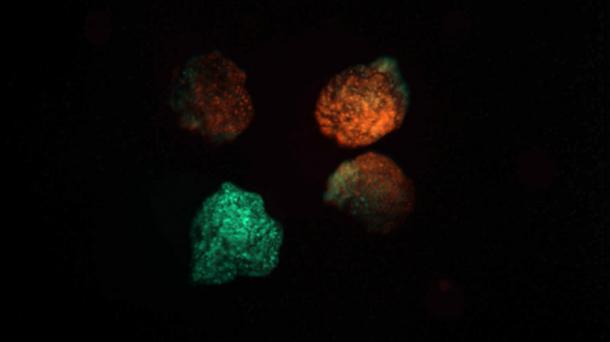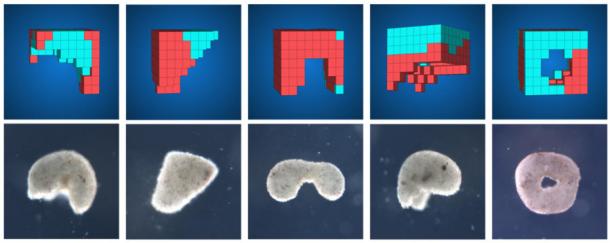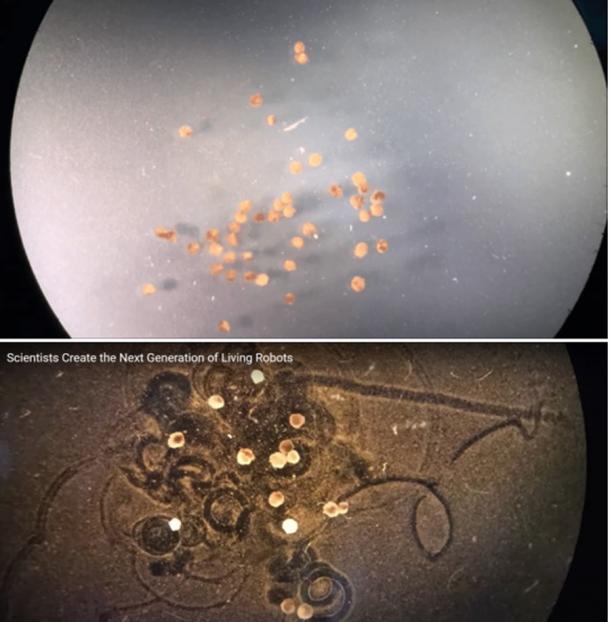-
- In a staggering new breakthrough that appears to be straight out of the pages of science fiction, scientists have created the first-ever living robots that can self-replicate. The team of biologists and computer scientists from Tufts University, the University of Vermont, and Harvard University have published their living robots research in the
Proceedings of the National Academy of Sciences
-
- journal. “I was astounded by it,” said Michael Levin, a professor of biology and director of the Allen Discovery Center at Tufts University who is co-lead author of the study, reports
CNN
- .

Experiences are recorded by living robots through color changes. (Doug Blackiston / Tufts Now )
Living Robots: “An Entirely New Life Form”
Living robots are known as xenobots: tiny life forms less than a millimeter (0.4 inches) wide that were created from the stem cells of African clawed frogs (Xenopus laevis), from which they get their name. The machine-animal hybrids that their creators say are “an entirely new life form,” as reported by inews, were first announced by the scientists in 2020 after experiments showed that xenobots could move, work together in groups, and self-heal. The third-generation living robots (xenobots 3.0) can self-propel using hair-like legs called cilia, have the ability to record memories, and replicate.
“We found Xenobots that walk. We found Xenobots that swim. And now, in this study, we’ve found Xenobots that kinematically replicate. We’ve discovered that there is this previously unknown space within organisms, or living systems, and it’s a vast space,” said lead author Joshua Bongard, according to the Mail Online .

AI methods automatically design diverse living robot candidate lifeforms in simulations (top row) to perform some desired function. Then, transferable designs are created using a cell-based construction toolkit to create living systems (bottom row) with the predicted behaviors. (Kriegman, S., Blackiston, D., Levin, M., Bongard, J. / CC BY 4.0 )
How Were the Living Robots Created?
To make the xenobots, the scientists scraped off stem cells, unspecialized cells that can develop into different cell types, from frog embryos and left them to incubate. No gene modification was done.
“Most people think of robots as made of metals and ceramics but it’s not so much what a robot is made from but what it does, which is act on its own on behalf of people. In that way it’s a robot but it’s also clearly an organism made from genetically unmodified frog cell,” Bongard said to CNN.
The original xenobots were spherical in shape and made of around 3000 cells, which were cut and joined together by a microsurgeon under a microscope using tiny forceps and a miniscule electrode. The shape was specified by artificial intelligence (AI) software. These living robots could reproduce but only rarely and only under specific circumstances.
The researchers then tested billions of body shapes, again using AI, to make the xenobots more effective at self-replication. The computer finally came up with a C-shape that resembled Pac-Man from the 1980s video game.
Individual living robots were able to find tiny stem cells in a petri dish, gather hundreds of them inside its mouth, assemble and compress them, and release them from their Pac-Man-shaped mouths. These “babies” become new xenobots that look and move just like their parents. The process then carries on as the baby xenobots themselves reproduce.
In a Xenopus laevis frog, these cells would generally have developed into skin, but by putting them into a new context, the scientists say they’ve given them the chance to reimagine themselves.
“These cells have the genome of a frog, but, freed from becoming tadpoles, they use their collective intelligence, a plasticity, to do something astounding,” said Levine to the Mail Online.

Groups of living robots can move particles in their environment. (YouTube screenshot / Tufts University )
Xenobots: Applications from Healthcare to Environment
Adding the caveat that it is very early days yet, the scientists believe that this combination of molecular biology and artificial intelligence can be put to a wide range of uses from cleaning up the environment to customized medicine delivery, and the detection of cancerous cells. According to the study researchers, living robots could be programmed to move through the arteries cleaning up plaque or through oceans clearing up microplastics or toxic chemicals. They could also be used to heal wounds, clear arthritic joints, and create tissue material for organ transplants .
Addressing any ethical concerns that may be raised about self-replicating machines, the team said xenobots are entirely lab contained and easily extinguished and are regulated by federal, state and institutional ethics experts. “This is an ideal system in which to study self-replicating systems. We have a moral imperative to understand the conditions under which we can control it, direct it, douse it, exaggerate it. It’s important, for society as a whole, that we study and understand how this works,” Bongard said to the Mail Online .
Whether this fascinating new life form will be able to perform any or all the important functions its creators foresee, remains to be seen. But there is no doubt that it is clearly a very significant scientific breakthrough .
Top image: The living robots created by scientists in a lab using computer AI can swim around in liquids by beating small hairs on their surface. Source: Tufts University
By Sahir Pandey
Source: www.ancient-origins.net/news-science-space/living-robots-0016129
